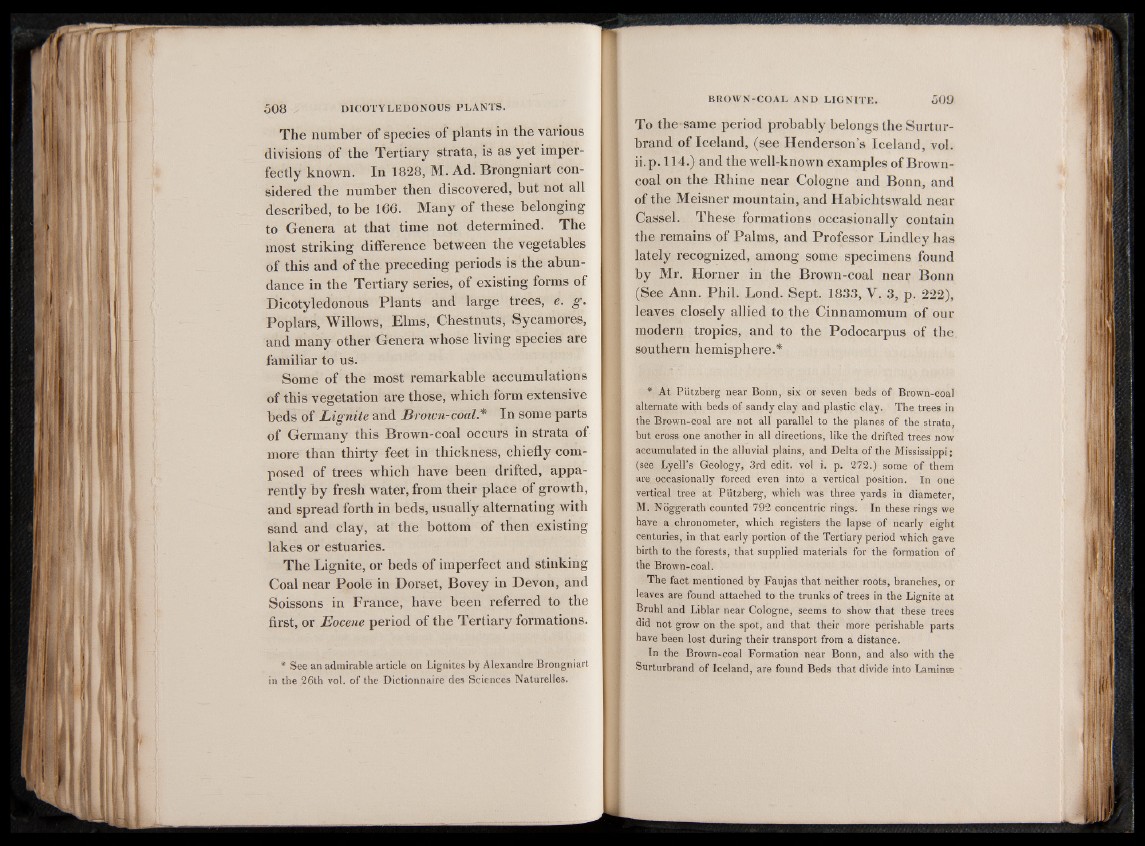
The number of species of plants in the various
divisions of the Tertiary strata, is as yet imperfectly
known. In 1828, M. Ad. Brongniart considered
the number then discovered, but not all
described, to be 166. Many of these belonging
to Genera at that time not determined. The
most striking difference between the vegetables
of this and of the preceding periods is the abundance
in the Tertiary series, of existing forms of
Dicotyledonous Plants and large trees, e. g .
Poplars, Willows, Elms, Chestnuts, Sycamores,
and many other Genera whose living species are
familiar to us.
Some of the most remarkable accumulations
of this vegetation are those, which form extensive
beds of Lignite and Brown-coal.* In some parts
of Germany this Brown-coal occurs in strata of
more than thirty feet in thickness, chiefly composed
of trees which have been drifted, apparently
by fresh water, from their place of growth,
and spread forth in beds, usually alternating with
sand and clay, at the bottom of then existing
lakes or estuaries.
The Lignite, or beds of imperfect and stinking
Coal near Poole in Dorset, Bovey in Devon, and
Soissons in France, have been referred to the
first, or Eocene period of the Tertiary formations.
* See an admirable article on Lignites by Alexandre Brongniart
in the 26th vol. of the Dictionnaire des Sciences Naturelles.
BROWN-COAL AND LIGNITE. 509
To the same period probably belongs the Surtur-
brand of Iceland, (see Henderson’s Iceland, vol.
ii.p. 114.) and the well-known examples of Brown-
coal on the Rhine near Cologne and Bonn, and
of the Meisner mountain, and Habichtswald near
Cassel. These formations occasionally contain
the remains of Palms, and Professor Lindley lias
lately recognized, among some specimens found
by Mr. Horner in the Brown-coal near Bonn
(See Ann. Phil. Lond. Sept. 1833, V. 3, p. 222),
leaves closely allied to the Cinnamomum of our
modern tropics, and to the Podocarpus of the
southern hemisphere.*
* At Piitzberg near Bonn, six or seven beds of Brown-coal
alternate with beds of sandy clay and plastic clay. The trees in
the Brown-coal are not all parallel to the planes of the strata,
but cross one another in all directions, like the drifted trees now
accumulated in the alluvial plains, and Delta of the Mississippi;
(see Lyell’s Geology, 3rd edit, vol i. p. 272.) some of them
are occasionally forced even into a vertical position. In one
vertical tree at Piitzberg, which was three yards in diameter,
M. Noggerath counted 792 concentric rings. In these rings we
have a chronometer, which registers the lapse of nearly eight
centuries, in that early portion of the Tertiary period which gave
birth to the forests, that supplied materials for the formation of
the Brown-coal.
The fact mentioned by Faujas that neither roots, branches, or
leaves are found attached to the trunks of trees in the Lignite at
Bruhl and Liblar near Cologne, seems to show that these trees
did not grow bn the spot, and that their more perishable parts
have been lost during their transport from a distance.
In the Brown-coal Formation near Bonn, and also with the
Surturbrand of Iceland, are found Beds that divide into Laminae